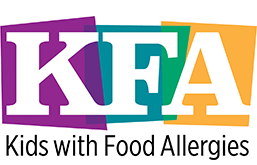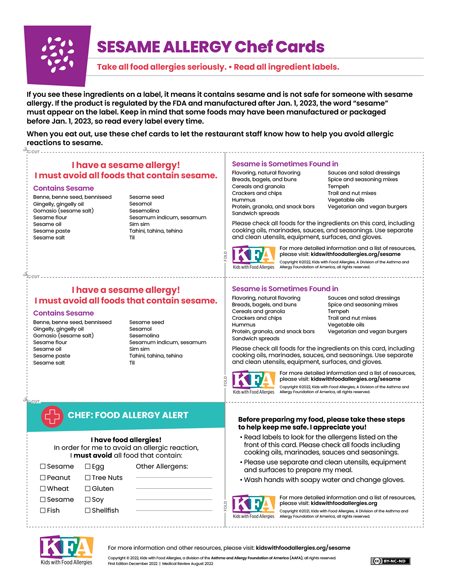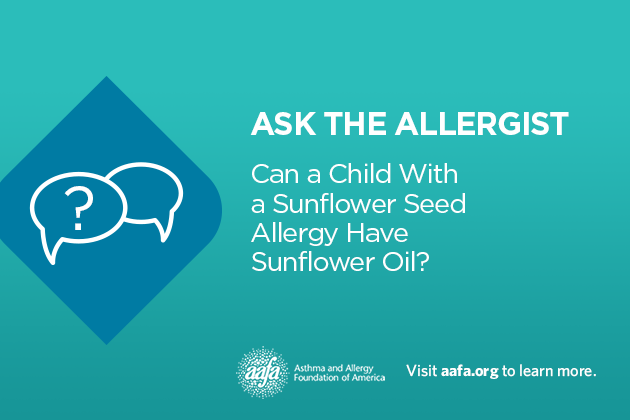Living with Food Allergies

Sesame Allergy
Sesame allergy is becoming more common in the United States.
Although more people are aware of sesame allergy, experts really don’t know how many people have a true sesame allergy. You may test positive on allergy tests but aren’t really allergic to sesame. But if you have a true sesame allergy, this guide will help you manage sesame allergy with confidence.
Closed
What are the symptoms of sesame allergy?
A sesame allergy is usually an immunoglobulin E (IgE) mediated allergy. This means your immune system makes antibodies called IgE antibodies. These IgE antibodies react with sesame and cause symptoms. This has the potential to cause a severe allergic reaction called anaphylaxis [anna-fih-LACK-sis].
When you have sesame allergy, you need to be aware of the symptoms of anaphylaxis. Symptoms of anaphylaxis may include hives, vomiting, or trouble breathing. The treatment for anaphylaxis is injectable epinephrine.
Signs and symptoms of anaphylaxis in children, teens, and adults include:
- Skin rash, itching, hives
- Swelling of the lips, tongue, or throat
- Shortness of breath, trouble breathing, wheezing
- Stomach pain, vomiting, diarrhea
- Feeling like something awful is about to happen
Common signs and symptoms of anaphylaxis in infants and toddlers include:1
- Skin rash, itching, hives
- Swelling of the lips, tongue, or throat
- Stomach pain, vomiting, diarrhea, spitting up
- Hiccups
- Arching back, bringing knees to the chest
- Coughing, wheezing
- Rubbing eyes, itchy or red eyes
How do doctors diagnose sesame allergy?
A doctor will do a physical exam and ask questions about medical history. They will ask what happens when sesame is eaten. They may order allergy testing to help confirm the diagnosis. A skin prick test or a blood test known as a specific IgE test may be used by your doctor to diagnose this food allergy.
Your doctor may also recommend a test called an oral food challenge. This test is done by an allergist. It is the gold standard to diagnose a food allergy or confirm if your child has outgrown the allergy. Sometimes an oral food challenge is necessary when your child’s medical history is not entirely clear. Also, a positive skin or blood test to sesame may not mean your child is allergic to sesame. In people who do not have a clear history of having a reaction to sesame, an oral food challenge is the only way to truly confirm the allergy.
How can I prevent sesame allergy reactions?
Sesame can be tricky to avoid. Sesame seeds are tiny and can easily fall off baked goods that contain them. They can find their way into other breads and foods not meant to contain sesame if they are near.
The only way to avoid an allergic reaction to sesame is to remove it from your diet. You can successfully manage your sesame allergy.
What you can do:
- Work with your doctor
- Read labels
- Be aware of cross-contact (when foods come into contact with each other and may transfer an allergen into a food that shouldn’t have it)
- Clearly communicate with school staff, people who prepare your food, and babysitters and other caregivers
How to do I read labels for sesame ?
Sesame seeds come from the sesamum indicum plant. Sesame seeds can be found in many foods, especially baked goods and spice mixes. Sesame oil and pastes made from sesame seeds can be found in many spreads and sauces. Sesame is also a staple in many popular ethnic dishes.
Under the Food Allergen Labeling and Consumer Protection Act (FALCPA), food companies must label their products clearly if they contain the foods that the FDA declares to be major allergens. In 2021, the Food Allergy Safety, Treatment, Education, and Research Act of 2021, also called the FASTER Act, added sesame to the list of major allergens recognized by the Food and Drug Administration (FDA). Food companies were given until Jan. 1, 2023, to update labels of products containing sesame.
Some food companies updated their labeling practices before that date. But foods produced before Jan. 1, 2023, may still be available for purchase. Remember that you still need to read every label every time.
When reading labels for sesame, look for sesame in parentheses after an ingredient in the ingredient list. Then look for sesame in a statement under the ingredient list. Sometimes it will be in bold. For example:
- Tahini (ground sesame)
- Contains: Sesame seeds
Some food companies put advisory statements on their labels. They may say “may contain sesame” or “made in a facility with sesame.” These labels can be confusing and may not tell you the actual risk of the product. If you have questions about advisory labels, talk with your allergist.
The FALCPA does not apply to all foods and everything that may contain sesame though. This means sesame could be “hidden” in products or listed under other names. Or you may not be able to find out the exact ingredients. These foods and products do not have to have sesame clearly listed or labeled and may contain sesame:
- Arts and crafts supplies
- Prescription and over-the-counter drugs
- Cosmetics and personal care items (such as makeup, lotions, and soaps)
- Alcohol
- Pet food
- Food served in restaurants, cafeterias, or by other food service providers
There are many different names for sesame. When shopping and cooking, have a list of the different names of sesame on hand. This makes it easy to check food packages for sesame ingredients. We have compiled a list of the different names of sesame below.
Most states in the U.S. do not have regulations on food allergies and restaurants. Ingredients in restaurant foods may vary. Cross-contact is also more likely. Many restaurants are becoming more food allergy aware, though. Look for places that have food allergy policies and allergy menus. Give the staff a chef card that alerts them to your allergy and lists sesame ingredients for them to watch for (see below).
Sesame ingredient list
Sesame Ingredient List:
If you see these ingredients on a label, it means it contains sesame and is not safe for someone with a sesame allergy.
For products regulated by the FDA and manufactured after Jan. 1, 2023, the word “sesame” must appear on the label. Remember that some foods may have been manufactured or packaged before Jan. 1, 2023, so read every label every time.
CONTAINS SESAME
The following ingredients found on a label indicate the presence of sesame. All labels should be read carefully before consuming a product, even if it has been used safely in the past.
Benne, benne seed, benniseed
Gingelly, gingelly oil
Gomasio (sesame salt)
Sesame flour
Sesame oil
Sesame paste
Sesame salt
Sesame seed
Sesamol
Sesemolina
Sesamum indicum, sesamum
Sim sim
Tahini, tahina, tehina
Til
SESAME IS SOMETIMES FOUND IN
Flavoring, natural flavoring
Breads, bagels, and buns
Cereals, especially granola and muesli
Crackers and chips
Hummus
Protein, granola, and snack bars
Sandwich spreads
Sauces and salad dressings
Spice and seasoning mixes
Tempeh
Trail and nut mixes
Vegetable oils
Asian, Indian, and Middle Eastern dishes
Baba ghanoush
Goma doff – a Japanese dessert
Halvah – candy made from sesame paste
Pasteli – a type of Greek dessert
Stir fry
Sushi
Vegetarian and vegan burgers
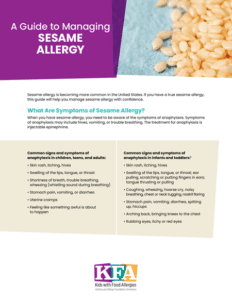 Download or Order Print Copies: “A Guide to Managing Sesame Allergy” (Includes Chef Cards and More) |
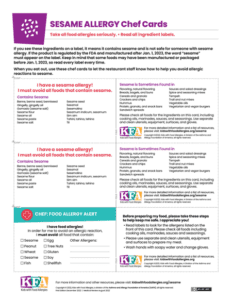 Download or Order Print Copies: Sesame Allergy Chef Cards |
How can I prevent sesame allergy reactions from cross-contact?
Cross-contact occurs when a food allergen comes in contact with food or an item not intended to contain that allergen. There are several precautions you should take to avoid food mix-ups and accidental cross-contact.
If you have both “safe” and “unsafe” versions of similar items (like hummus made with tahini and hummus made without tahini) in your home, take steps to make sure they are easily marked. If the containers look the same, create a system for your family to prevent accidents. It may be helpful to use colored stickers or to store the food with the allergen on a different shelf.
When you’re cooking, use separate utensils and kitchenware. For example, don’t use the same knife to cut a sandwich that contains sesame as you use to cut a sandwich made without sesame ingredients. You can find more tips on how to prevent allergic reactions in our article: 12 Tips for Avoiding Cross-Contact of Food Allergens
What can I substitute for sesame in recipes?
Sesame is usually a small part of recipes which makes it easier to swap with something else.
If a recipe calls for sesame oil, choose another flavorful oil. Options include olive, avocado, or nut oils (if you are not allergic to nuts).
Sesame seeds can be replaced with poppy seeds, hemp seeds, or chia seeds.
Tahini can be replaced with smooth nut or seed butter such as sunflower butter, pumpkin seed butter, soy nut butter, or peanut butter.
Will my child outgrow a sesame allergy?
Is there a treatment for sesame allergy?
Currently, there are no FDA-approved treatments for sesame allergy. The best way to prevent sesame allergy reactions is to avoid sesame completely. But some research is being done on sesame allergy treatments, such as oral immunotherapy (OIT).
Food Allergy Fact
As of 2023, food companies must treat sesame as an allergen on food labels.
Medical Review: August 2022 by Matthew Greenhawt, MD
References
1. Pistiner, M., Mendez-Reyes, J. E., Eftekhari, S., Carver, M., Lieberman, J., Wang, J., & Camargo, C. A. (2021). Caregiver-reported presentation of severe food-induced allergic reactions in infants and toddlers. The Journal of Allergy and Clinical Immunology: In Practice, 9(1). doi.org/10.1016/j.jaip.2020.11.005
2. Sesame Allergy Common Among Children With Food Allergies. (2019, November 18). National Institutes of Health (NIH). nih.gov/news-events/nih-research-matters/sesame-allergy-common-among-children-food-allergies
